
Day of the Tentacle, also known as Maniac Mansion II: Day of the Tentacle, is a 1993 graphic adventure game developed and published by LucasArts. It is the sequel to the 1987 game Maniac Mansion. The plot follows Bernard Bernoulli and his friends Hoagie and Laverne as they attempt to stop the evil Purple Tentacle - a sentient, disembodied tentacle - from taking over the world. The player takes control of the trio and solves puzzles while using time travel to explore different periods of history.

Monkey Island is a series of adventure games. The first four games were produced and published by LucasArts, earlier known as Lucasfilm Games. The fifth was developed by Telltale Games with LucasArts, while the sixth was developed by Terrible Toybox with Lucasfilm Games and Devolver Digital.

Loom is a 1990 fantasy-themed graphic adventure game by Lucasfilm Games. The project was led by Brian Moriarty, a former Infocom employee and author of classic text adventures Wishbringer (1985), Trinity (1986), and Beyond Zork (1987). It was the fourth game to use the SCUMM adventure game engine, and the first of those to avoid the verb–object interface introduced in Maniac Mansion.
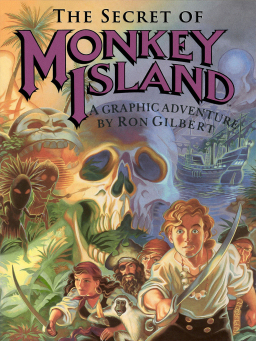
The Secret of Monkey Island is a 1990 point-and-click graphic adventure game developed and published by Lucasfilm Games. It takes place in a fictional version of the Caribbean during the age of piracy. The player assumes the role of Guybrush Threepwood, a young man who dreams of becoming a pirate, and explores fictional islands while solving puzzles.
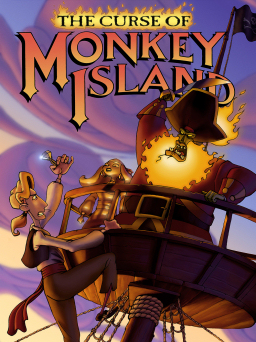
The Curse of Monkey Island is an adventure game developed and published by LucasArts in 1997. A sequel to 1991's Monkey Island 2: LeChuck's Revenge, it is the third game in the Monkey Island series.
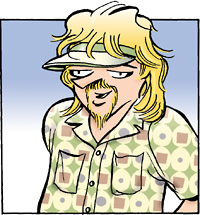
Zonker Harris is the stereotypical unfocused confused hippie character in Garry Trudeau's comic strip Doonesbury. He made his first appearance as a perennial pot-smoking pest plaguing B.D.'s football team in 1971. He moved with Mike, B.D., and the gang to a rural commune.

Monkey Island 2: LeChuck's Revenge is an adventure game developed and published by LucasArts in 1991. A sequel to 1990's The Secret of Monkey Island, it is the second game in the Monkey Island series. It was the sixth LucasArts game to use the SCUMM engine, and the first game to use the iMUSE sound system. In it, pirate Guybrush Threepwood searches for the legendary treasure of Big Whoop and again faces off against the pirate LeChuck, who is now an undead corpse.

Deluxe Paint, often referred to as DPaint, is a bitmap graphics editor created by Dan Silva for Electronic Arts and published for the then-new Amiga 1000 in November 1985. A series of updated versions followed, some of which were ported to other platforms. An MS-DOS release with support for the 256 color VGA standard became popular for creating pixel graphics in video games in the 1990s.
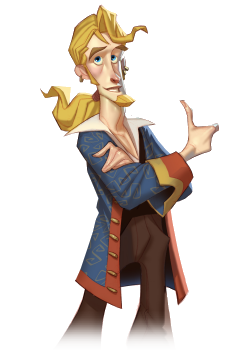
Guybrush Ulysses Threepwood is a fictional character who serves as the main protagonist of the Monkey Island series of computer adventure games by LucasArts. He is a pirate who adventures throughout the Caribbean in search of fame and treasure alongside his love interest and later wife, Elaine Marley, often thwarting the plans of the undead pirate LeChuck in the process. Though a "mighty pirate" by his own account, he is a rather clumsy and disorganized protagonist throughout the series. It is a running joke throughout the games for characters to garble Guybrush Threepwood's unusual name, either deliberately or accidentally. In all voiced appearances, Guybrush has been portrayed by actor Dominic Armato.

Escape from Monkey Island is an adventure game developed and released by LucasArts in 2000. It is the fourth game in the Monkey Island series, and the sequel to the 1997 videogame The Curse of Monkey Island. It is the first game in the series to use 3D graphics and the second game to use the GrimE engine, which was upgraded from its first use in Grim Fandango.

From the late 1980s to the early 2000s, LucasArts was well known for their point-and-click graphic adventure games, nearly all of which received high scoring reviews at the time of their release. Their style tended towards the humorous, often irreverent or slapstick humor, with the exceptions of Loom and The Dig. Their game design philosophy was that the player should never die or reach a complete dead-end, although there were exceptions.

Ron Gilbert is an American video-game designer, programmer, and producer. His games are generally focused on interactive story-telling, and he is arguably best known for his work on several LucasArts adventure games, including Maniac Mansion and the first two Monkey Island games. In 2009, he was chosen by IGN as one of the top 100 game creators of all time.

Dominic Armato is an American voice actor, journalist and food critic. He is best known for his work on LucasArts games. His most famous role is the voice of the pirate Guybrush Threepwood in the Monkey Island series.
iMUSE is an interactive music system used in a number of LucasArts video games. The idea behind iMUSE is to synchronize music with the visual action in a video game so that the audio continuously matches the on-screen events and transitions from one musical theme to another are done seamlessly. iMUSE was developed in the early 1990s by composers Michael Land and Peter McConnell while working at LucasArts. The iMUSE system was patented by LucasArts in 1994, after being added to the fifth version of the SCUMM game engine in 1991.
The surname Threepwood may refer to:

DeathSpank, also known as DeathSpank: Orphans of Justice, is an action role-playing video game developed by Hothead Games and published by Electronic Arts. It was created by game designers Ron Gilbert and Clayton Kauzlaric. The game was released on July 13, 2010 on the PlayStation 3 via the PlayStation Network and on July 14, 2010 on the Xbox 360 via Xbox Live Arcade. The Microsoft Windows and Mac OS X versions were released October 26, 2010 and December 14, 2010 respectively, via Steam.
Alexandra Boyd is a British actress, director, screenwriter and producer. Her acting credits include Clarissa Mason in Coronation Street and Sarah Olmsted in Mr Holland's Opus. In recent years she has turned to screenwriting and film directing. She wrote and directed her debut feature Widow's Walk which debuted on Amazon Prime in December 2019.
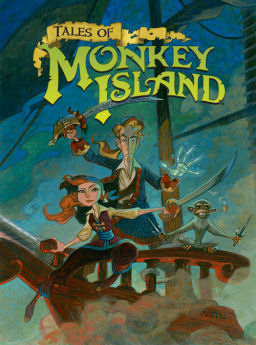
Tales of Monkey Island is a 2009 graphic adventure video game developed by Telltale Games under license from LucasArts. It is the fifth game in the Monkey Island series, released nearly a decade after the previous installment, Escape from Monkey Island. Developed for Windows and the Wii console, the game was released in five episodic segments, between July and December 2009. In contrast to Telltale's previous episodic adventure games, whose chapters told discrete stories, each chapter of Tales of Monkey Island is part of an ongoing narrative. The game was digitally distributed through WiiWare and Telltale's own website, and later through Steam and Amazon.com. Ports for OS X, the PlayStation Network, and iOS were released several months after the series ended.
Peter Chan is an American freelance concept and storyboard artist and animator for video games and films. Chan is best known for his work in several LucasArts adventure games, including Monkey Island 2: LeChuck's Revenge, Day of the Tentacle, Full Throttle, and Grim Fandango.
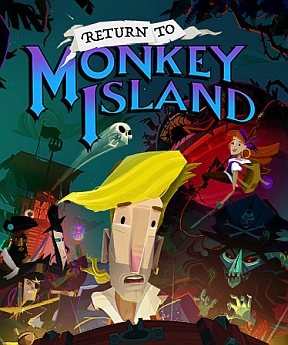
Return to Monkey Island is a point-and-click adventure game developed by Terrible Toybox and published by Devolver Digital. The sixth Monkey Island game, it was released for macOS, Nintendo Switch, and Windows on September 19, 2022, for Linux on October 26, 2022, for PlayStation 5 and Xbox Series X/S on November 8, 2022, and for iOS and Android on July 27, 2023. It was the first Monkey Island game by the series' creator, Ron Gilbert, since Monkey Island 2: LeChuck's Revenge (1991).


















